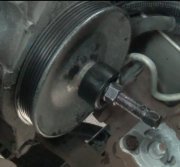Thanks for your comments, but the dealers don't necessarily charge more. I was the alignment specialist at a very nice family-owned Chrysler dealership through all of the 1990s. People came to us to get second opinions after getting unreasonable estimates at the Midas franchise across the street. At the same time, we rolled our eyes when we heard what the local Goodyear dealer was charging per hour for labor, and for alignments. My dealership was actually one of the lowest-priced places in our city.
Also realize that what dealers mostly see are cars still under warranty, or those owned by happy customers from years earlier who hadn't found other shops they preferred to go to. As such, most of what I worked on wasn't all rusty yet, or old enough to have sagged springs. The cars were new enough to be owned by people with money to keep good tires on them.
Before this, I worked at a Sears Auto Center. We had the most antiquated alignment equipment imaginable, but we were able to get good results with it. We hadn't even heard of an "alignment computer".
We also have about a dozen tire and alignment specialty shops in my city, most with very good reputations. The quality of the alignments have more to do with the managers than with the equipment. One manager in particular is extremely fussy about what his employees must do before a car is considered "good enough" to give back to the customer. At my dealership, I had a reputation of taking "a little longer than everyone else", as the office manager put it, "but we knew your cars weren't coming back with complaints". Sometimes that means running it up on the rack a second time to get the steering wheel perfectly straight. It's the pits when you get paid 1.3 hours to do a four-wheel alignment, but you know it's going to be 1.7 hours before you're satisfied. When I took too long, I worked part of that time for free, so I lost and the dealer lost, but in my ten years at the dealership, the last nine as their only alignment tech, no one ever once yelled at me for working too slowly. It was better to give away a little of my labor today than to have to do the job over for free another day.
Also be aware all alignment computers can be set to read angles to tenths of a degree or to hundredths of a degree. When you're interested in speed, you set it to read to tenths of a degree. It's real easy to get all the number to turn green, meaning they're in specs, but conscientious mechanics set their computers to read to hundredths of a degree for more accuracy. Another advantage of working at the dealership was I saw mostly the same models every day, and I knew what worked best for them. In the case of all the front-wheel-drive cars and minivans, I found that if I adjusted in 0.06 degrees camber pull to the left to offset road crown, I never had a customer come back with a complaint of pulling. 0.04 degrees wasn't enough, and 0.10 was too much. If the computer was set to round those readings off to tenths of a degree, 0.24 would be rounded off to 0.2 degrees, and 0.30 would be 0.3 degrees. That gave a perfect 0.06 degree difference, but on the computer it looked like 0.1, which is too much.
0.27 and 0.33 degrees would also be perfect, but the computer would show both sides equal at 0.3 degrees, which is not good. To put this in perspective, when we used old equipment with light bulbs and metal scales, we could read them to 1/8th degree accuracy, and to 1/16th degrees if we were careful. That was fine for old, heavy rear-wheel-drive cars, but as I pointed out, newer cars need to be dialed in to much tighter tolerances.
Now, to be fair to your comment about dealers charging more, we have a Buick / GMC dealer just down the road, a Cadillac dealer across town, and we used to have a fantastic import dealer, and a reputable Ford dealer. All of us would borrow service manuals back and forth, and we'd often fix each others' trade-ins. The one notable exception was the Chevy dealer. He has to be one of the biggest crooks in the county if not the state. People who insist on owning a Chevy often drive 15 or 30 miles to other cities to avoid the dealer right here. He is the guy who gives all dealers a bad rap, and he has bought up the Ford and multiple import dealers. He has done wonders for Chrysler, Dodge, and GMC sales due to all the customers he has made angry. GM has a lot of ways figured out on how to separate you from your money after the sale, but this dealer takes that to a whole new level. The rest of the dealers have a steady stream of happy, repeat customers. Mechanics often know them by name, and they ask to have certain people work on their cars.
You know you're doing something right when some customer comes in with a huge box of donuts about once a week.
Thanks for adding your comments.
Saturday, October 26th, 2019 AT 6:32 PM




